|
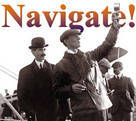
 Up
Up 
 The Patent
The Patent
Pool

(You are here.)
 Down
Down




  Need
to Need
to
find your
bearings?
Try
these
navigation aids:
If
this is your first
visit, please stop by:
Something
to share?
Please:



|
|
Available in Française, Español, Português, Deutsch, Россию,
中文,
日本, and others.
 here
was no need for further flights. The politicking had worked – sort
of. On March 3, 1915, Congress had created the National Advisory
Council for Aeronautics (NACA) "to supervise and direct the
scientific study of the problems of flight with a view to their
practical solution." It was established as an entity separate from
the Smithsonian or any other institution – not exactly what Walcott
had wanted. However, Walcott was appointed to the governing council,
made head of the executive committee, and was then chosen to lead
the new NACA a few years later. He remained in control for the rest
of his life. And he was eventually able to build an experimental
facility with Langley’s namesake, although the Langley Memorial
Aeronautical Laboratory ended up in Newport News, Virginia rather
than Washington DC. It was a not-so-classic case of a politician not
getting his cake and eating it anyway. here
was no need for further flights. The politicking had worked – sort
of. On March 3, 1915, Congress had created the National Advisory
Council for Aeronautics (NACA) "to supervise and direct the
scientific study of the problems of flight with a view to their
practical solution." It was established as an entity separate from
the Smithsonian or any other institution – not exactly what Walcott
had wanted. However, Walcott was appointed to the governing council,
made head of the executive committee, and was then chosen to lead
the new NACA a few years later. He remained in control for the rest
of his life. And he was eventually able to build an experimental
facility with Langley’s namesake, although the Langley Memorial
Aeronautical Laboratory ended up in Newport News, Virginia rather
than Washington DC. It was a not-so-classic case of a politician not
getting his cake and eating it anyway.
It also solved
Curtiss’ problems, although not in the way that he had expected.
Orville never took full advantage of the patent suit that he had
won. Once the Wright patent was awarded pioneer status, the Wright
Company re-filed against Curtiss but no one else. Curtiss filed for
an extension and continued to ship airplanes, as did many other
American manufacturers – in short, nothing changed. Instead of
moving to create a patent monopoly, Orville concentrated on buying
up stock from the shareholders of the Wright Company.
In October 1915,
when he had acquired the majority of the stock, Orville Wright sold
the Wright Company along with its patents to a group of New York
investors led by mining tycoon William Boyce Thompson. Over the next
year the reconstituted Wright Company acquired the Crane-Simplex
Automobile company and the Glenn L. Martin Aircraft Company, then
renamed this expanded manufacturing conglomerate as the
Wright-Martin Aircraft Corporation. The Wright-Martin partners had
paid somewhere between $250,000 and $500,000 for the Wright patent,
and to make back their investment they began licensing the patent as
the Wright Company had done years before. On 18 December 1916, Wright-Martin sent letters to all the
major American aircraft manufacturers asking them for a fee of 5% of
the cost of each new airplane
with a
$10,000 annual minimum. While this wasn't as drastic as a patent
monopoly, it was nonetheless perceived as a potential burden to the
aircraft industry – especially by the industry’s biggest customer,
the U.S. military.As the First
World War progressed and America’s participation loomed, the
military had increased their orders for airplanes. Curtiss reported
sales of $6 million in 1915, and in October 1916 the Wall Street
Journal reported that he had $11 million in orders. That would more
than double before the end of the year. The military feared that
with orders on the rise, the aircraft industry would pass the
licensing fees on to them. In response, the War and Navy departments
met with Charles Walcott in late December of 1916, after which the
Franklin D. Roosevelt – then the Assistant Secretary of the Navy –
sent a letter to NACA on 13 January 1917 calling it’s attention to a
“serious state of affairs…brought about by the uncertainty of the
situation as regards aeronautic patents.” He asked that NACA study
the situation and suggest “some line of action to be taken.” This
was well outside of NACA’s charter; it was responsible for research
in aeronautic science and had no authority over the aviation
business. But such was Walcott’s reputation as an effective
politician that the military came to him for a solution.
On 5 February 1917, Walcott sent a
letter to President Woodrow Wilson, advising him of the “patent
situation,” quoting Roosevelt’s letter, and claiming that airplane
manufacturers had “greatly increased the sale prices of their
products.” He also indentified the Wright patent as the single
greatest cause of this looming problem and suggested that the
government secure all the troublesome aeronautical patents “by
purchase or condemnation.” Secretary of the Navy Josephus Daniels
sent a copy of Walcott’s letter to the Chairman of the House
Committee on Naval Affairs, along with President Wilson’s approval.
Chairman Lemuel P. Padgett attached a rider to a naval appropriation
bill then before Congress “…to enable the Secretary of War and the
Secretary of the Navy to secure by purchase, condemnation, donation,
or otherwise, such basic patent or patents as they may consider
necessary to the manufacture and development of aircraft in the
United States and its dependencies, for governmental and civil
purposes...” The bill was passed 13 February 1917 and the military
assigned this responsibility to Walcott. On 20 February 1917 –
before the bill was signed into law – NACA sent letters to the major
American aviation manufacturers, requesting them to submit lists of
the patents they owned.
On 23 March, NACA floated the idea
of a “patent pool” to the manufacturers. Instead of a 5% royalty for
patents, as proposed by Wright-Martin, the government would pay
1.25%. Not surprisingly, the manufacturers resisted. But NACA had a
very big carrot and a very big stick to convince them to cooperate.
The carrot was the promise of increased orders for airplanes,
engines, and other aviation equipment. The stick was the threat of
“condemnation.” Since the government had awarded the patents, it
could also take them away. Wright-Martin and Curtiss agreed to the
pool in June 1917 and were immediately rewarded with multi-million
dollar contracts. Other major companies followed in July. NACA
incorporated the patent pool as the Manufacturer’s Aircraft
Association (MAA). Dr. Joseph Ames of John Hopkins University, a
member of the NACA board with no known business interests, was
listed as the first incorporator.
Of all the members, Curtiss
benefited most from MAA patent pool. Upon joining, a manufacturer
was freed from “…any and all claims which they or any of them may
have had against each other for damages and profits on account of
any infringement, or alleged infringement.” Not surprisingly
Curtiss’ lawyer, W. Benton Crisp, had written the agreement. Curtiss
never had the need or the opportunity to try the Aerodrome defense
in court.
Orville no
longer had any financial interest in the Wright patent, of course,
but he was also affected by the MAA in a subtle yet important way.
With the advent of the patent pool and the threat of a patent
monopoly lifted, the negative press that the Wright name had
suffered for waging the “patent wars” stopped. Slowly, the Wright
brothers’ reputation began to recover. The public perception of
Orville changed from that of a greedy industrial magnate to the
grand old man of aviation.
|
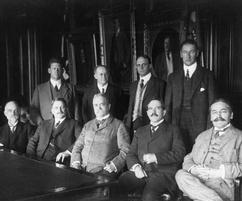
The first meeting of the National Advisory Council for Aeronautics
on 23 April 1915. Seated from Left to Right: Dr. William Durand,
Stanford University, California, Dr. S.W. Stratton, Director, Bureau
of Standards, Brig.Gen. George P. Scriven, Chief Signal Officer, War
Dept, Dr. C.F. Marvin, Chief, United States Weather Bureau, Dr.
Michael I Pupin, Columbia University, New York. Standing: Holden C.
Richardson, Naval Instructor, Dr. John F. Hayford, Northwestern
University, Illinois, Capt. Mark L. Bristol, Director of Naval
Aeronautics, Lt. Col. Samuel Reber, Signal Corps, Aviation Section.
Also present at this meeting were Dr. Joseph S. Ames, Johns Hopkins
University, Baltimore, MD, and Hon. B. R. Newton, Asst. Secretary of
Treasury. Not present was Charles Walcott, Secretary, Smithsonian
Institution. All twelve of these men were appointed by President
Woodrow Wilson. Orville Wright would be asked to join the council in
1920.
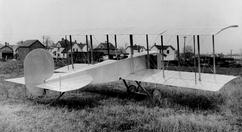
The 1916 Wright Model L was the last airplane produced by the Wright
Company. By this time, Orville had sold the company and was only
serving as an advisor. That same year, the Wright Company would
merge with the Glenn L. Martin Aircraft Company and the
Crane-Simplex Automobile Company to form the Wright-Martin Aircraft Corporation.
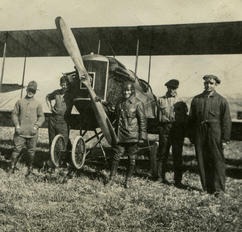
Glenn Martin (in flying togs) with a 1915 "Martin T" tractor biplane
he designed for the U.S. Army. Martin left the Wright-Martin
Aircraft Corporation
within a year of the merger and started another airplane company.
Wright-Martin went on to merge with Curtiss' company in 1929 to
become the Curtiss-Wright Corporation.
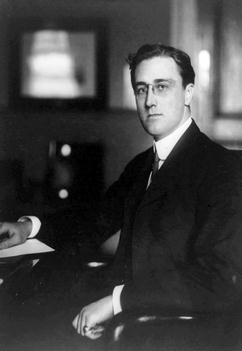
Franklin D. Roosevelt as Assistant Secretary of the Navy in 1913. He
occupied the the same position as his fifth cousin, Theodore
Roosevelt, in 1897.
|